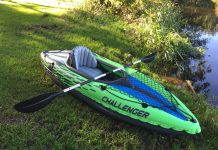
No matter what kind of camping you’re doing - deep in the mountains or overnight at the local RV park - many basic camping skills apply. Learning them all takes time, practice, and a few mistakes. Learning to avoid some of the mistakes, however, doesn’t have to be difficult.
As a backpacking guide, I’ve spent many nights camping on the trail with people of all ages and experience levels. Not everything goes to plan each time, but there’s always something to be learned.
Today, I’m going to share with you my top 10 camping tips to help keep you safe, environmentally conscious, and having fun when you’re camping.
#1 Know the Camp Triangle
When you’re camping, it’s critical to space your campsite, kitchen, and food storage apart from one another in order to avoid animal encounters and adhere to basic outdoor recreation standards.
This video by Leave No Trace Center for Outdoor Education, a group founded to teach ethical outdoor living, demonstrates the rule of thumb for spacing your campsite, kitchen, and food storage.
#2 Learn to Pack Your Own Meals
Few things add to the expense of camping quite as quickly as purchasing premade dehydrated meals. These meals come from sources like Backpacker’s Pantry or Mountain Home and lack nutrition, flavor, and texture.
Instead, try packing your own meals made from instant ingredients (instant potatoes, minute rice, dehydrated refried beans, etc.) into gallon size Ziploc bags. Pour in boiling water, and wait for your meal to hydrate! More on freezer bag cooking.
#3 Pack It In, Pack It Out
This is one of the 7 LNT principles and basically dictates that you DO NOT throw away your trash. If you carry something into the wilderness for camping, then it’s your job to get it back out again.
Why? Because we’re all responsible for throwing away our trash and preserving public lands for those who come after us. We all share these recreational resources, so don’t be a jerk and spoil someone else’s enjoyment of the outdoors.
#4 Clear Debris Under Your Tent
Whether you’re using a tent, tarp, or other ground-based shelter, it pays to clear the area before pitching your living quarters.
Rocks, roots, and bumps are difficult or impossible to sleep on, and sharp sticks, broken glass, or other pointy objects can rip the groundsheet of your shelter or poke a hole in your sleeping pad. Clear the ground for a better night’s sleep.
#5 Avoid the Best-Looking Campsite

The best looking camp spots can turn out to be trouble
I see this mistake constantly – people set up their tent in a flat, clear spot. It never works well.
Those perfectly flat spots are usually the places where water gathers and stands during a hard rain. They’re clear of leaves and debris because the standing water puddle from the last storm carried all the debris away. Find some place flat but slightly sloped to avoid waking up in standing water. It’s happened to me before.
#6 Dispose of Waste Properly
I hate to beat a dead horse but… this is another of the 7 LNT principles.
I once set my pack down against a tree no more than 3 feet from the edge of the beautiful Appalachian Trail, to pick it up later and find that it was smeared with human feces. Someone had taken a dump on the ground right next to the trail and not even bothered to dispose of it properly. Needless to say, I was pissed (and I was leading a group at the time).
Keep an eye out for other people’s irresponsible land mines if camping in high traffic areas and always bury your own!
#7 Eat a High Calorie Snack Before Bed
In colder climates and cooler seasons, it can be hard to stay warm through the night when camping.
One of many tricks of the trade is to eat a high calorie snack just before bed. This gives your body plenty of easy-to-burn fuel throughout the night, and you’ll be a little snugger as you sleep.
#8 Learn the PCT Bear Bag Style
There are tons of ways to hang a bear bag (a method of protecting food while camping at night) and some are more useful than others.
One of the most versatile bear bag hanging methods is the Pacific Crest Trail method, which involves some rope, a mini carabiner, and a bag to hang the food in.
I highly recommend Dynaglide rope for bear hanging – it’s insanely thin, light, slippery, and strong enough to dangle a small car from a tree branch. At 2mm in diameter, it can handle loads of up to 1,000 lbs or half a ton! I’ve been using it for guylines and bear ropes for years.
#9 Learn and Use the Trucker’s Hitch
This little knot is just as useful tying the kayak to the car roof as it is for tensioning your tarp or tent when camping.
In the backcountry, having a repertoire of good knots can make a massive difference in your ability to effectively camp and your comfort levels.
Andrew Skurka, a well-known adventurer, explains many uses and modifications of the Trucker’s Hitch for setting up camp effectively.
#10 Check for Widowmakers
“A lot of people refer to these as Widowmakers, because they’ll kill you.”
This quote really sums up the idea in what might be woefully cursory terms. Widowmakers are branches, trees, loose rocks, or other natural hazards which could come crashing down in wind, rain, or storms, and squish the comfy camper below.
When setting up camp be sure to check for dead branches, dead trees, or other potential sources of widow-making.
Conclusion
There are so many tips, tricks, and variations of this topic that it’s impossible to ever exhaust all the questions and answers which circulate.
Ultimately the only way to know what works for you and what makes the most sense is to go out and do some camping yourself. Whether it’s back yard, backcountry, or at the campground with friends and family – you’ll learn so much just by getting out there and experiencing it yourself.
As an Amazon Associate, we earn from qualifying purchases. This is without any additional costs for the buyer but does support us in maintaining our website.



